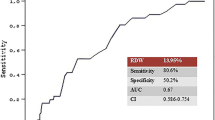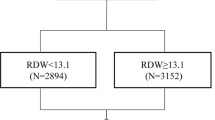Abstract
Background
This study aims to investigate the association between preoperative Red blood cell Distribution Width (RDW) and postoperative outcomes, including myocardial infarction (MI), and mortality.
Methods
A prospective cohort including all patients submitted to elective vascular arterial surgery at a university hospital. The primary and secondary outcomes were 30-day mortality and 30-day MI, respectively.
Results
Atrial fibrillation, chronic kidney disease (CKD), and dependent functional status were more prevalent in deceased patients. After multivariable analysis, age (adjusted OR 1.08, 95% Confidence Interval [1.01–1.15], p = 0.027) and RDW-standard deviation (RDW-SD) (1.08 [1.01–1.16], p = 0.032) remained independent predictors of mortality. Patients with MI had higher rates of diabetes, CKD, dependent functional status, ASA physical status IV, and insulin medication. After multivariable analysis, dependent functional status (4.8 [1.6–15.0], p = 0.007), insulin medication (4.4 [1.5–12.6], p = 0.007) and RDW-SD (1.10 [1.02–1.19], p = 0.020) were independent predictors of MI.
Conclusion
RDW-SD independently predicted postoperative MI and mortality, and may provide valuable information for prevention and early management of adverse outcomes.


Similar content being viewed by others
References
Afari ME, Bhat T (2016) Neutrophil to lymphocyte ratio (NLR) and cardiovascular diseases: an update. Expert Rev Cardiovasc Ther 14:573–577
Kofink D, Muller SA, Patel RS et al (2018) Routinely measured hematological parameters and prediction of recurrent vascular events in patients with clinically manifest vascular disease. PloS One 13:e0202682
Satilmis S, Karabulut A (2019) Correlation between red cell distribution width and peripheral vascular disease severity and complexity. Med Sci (Basel) 7(7):77
Isik T, Ayhan E, Kurt M et al (2012) Is red cell distribution width a marker for the presence and poor prognosis of cardiovascular disease? Eurasian J Med 44:169–171
Li N, Zhou H, Tang Q (2017) Red blood cell distribution width: a novel predictive Indicator for cardiovascular and cerebrovascular diseases. Dis Markers 2017:7089493
Duarte-Gamas L, Pereira-Neves A, Jacome F et al (2020) Red blood cell distribution width as a 5-year prognostic marker in patients submitted to carotid endarterectomy. Cerebrovasc Dis Extra 10:181–192
Salvagno GL, Sanchis-Gomar F, Picanza A et al (2015) Red blood cell distribution width: a simple parameter with multiple clinical applications. Crit Rev Clin Lab Sci 52:86–105
Pereira-Neves A, Rocha-Neves J, Fragao-Marques M et al (2021) Red blood cell distribution width is associated with hypoperfusion in carotid endarterectomy under regional anesthesia. Surgery 169(6):1536–1543
Veraldi GF, Mezzetto L, Scorsone L et al (2019) Red blood cell distribution width predicts 1-month complications after percutaneous transluminal angioplasty. J Med Biochem 38:468–474
Arbel Y, Finkelstein A, Halkin A et al (2012) Neutrophil/lymphocyte ratio is related to the severity of coronary artery disease and clinical outcome in patients undergoing angiography. Atherosclerosis 225:456–460
Reis P, Lopes AI, Leite D et al (2020) Incidence, predictors and validation of risk scores to predict postoperative mortality after noncardiac vascular surgery, a prospective cohort study. Int J Surg 73:89–93
Reis P, Lopes AI, Leite D et al (2019) Predicting mortality in patients admitted to the intensive care unit after open vascular surgery. Surg Today 49:836–842
Reis PV, Lopes AI, Leite D et al (2019) Major cardiac events in patients admitted to intensive care after vascular noncardiac surgery: a retrospective cohort. Semin Cardiothorac Vasc Anesth 23:293–299
von Elm E, Altman DG, Egger M et al (2014) The strengthening the reporting of observational studies in epidemiology (STROBE) statement: guidelines for reporting observational studies. Int J Surg 12:1495–1499
Agha R, Abdall-Razak A, Crossley E et al (2019) STROCSS 2019 guideline: strengthening the reporting of cohort studies in surgery. Int J Surg 72:156–165
Kristensen SD, Knuuti J, Saraste A et al (2014) 2014 ESC/ESA guidelines on non-cardiac surgery: cardiovascular assessment and management: the joint task force on non-cardiac surgery: cardiovascular assessment and management of the European Society of Cardiology (ESC) and the European Society of Anaesthesiology (ESA). Eur J Anaesthesiol 31:517–573
Thygesen K, Alpert JS, Jaffe AS et al (2018) Fourth universal definition of myocardial infarction (2018). J Am Coll Cardiol 72:2231–2264
Song SY, Hua C, Dornbors D 3rd et al (2019) Baseline red blood cell distribution width as a predictor of stroke occurrence and outcome: a comprehensive meta-analysis of 31 studies. Front Neurol 10:1237
Al-Kindi SG, Refaat M, Jayyousi A et al (2017) Red cell distribution width is associated with all-cause and cardiovascular mortality in patients with diabetes. Biomed Res Int 2017:5843702
Veraldi GF, Mezzetto L, Scorsone L et al (2018) Red blood cell distribution width (RDW) is an independent predictor of post-implantation syndrome in patients undergoing endovascular aortic repair for abdominal aortic aneurysm. Ann Transl Med 6:453
Usman R, Jamil M, Naveed M (2017) High preoperative neutrophil-lymphocyte ratio (NLR) and red blood cell distribution width (RDW) as independent predictors of native arteriovenous fistula failure. Ann Vasc Dis 10(3):205–210
Lee E, Choi EK, Han KD et al (2018) Mortality and causes of death in patients with atrial fibrillation: a nationwide population-based study. PLoS One 13:e0209687
Malaisrie SC, McCarthy PM, Kruse J et al (2018) Burden of preoperative atrial fibrillation in patients undergoing coronary artery bypass grafting. J Thorac Cardiovasc Surg 155:2358–2367
Banach M, Mariscalco G, Ugurlucan M et al (2008) The significance of preoperative atrial fibrillation in patients undergoing cardiac surgery: preoperative atrial fibrillation–still underestimated opponent. Europace 10:1266–1270
Liu M, Li XC, Lu L et al (2014) Cardiovascular disease and its relationship with chronic kidney disease. Eur Rev Med Pharmacol Sci 18:2918–2926
Scarborough JE, Bennett KM, Englum BR et al (2015) The impact of functional dependency on outcomes after complex general and vascular surgery. Ann Surg 261:432–437
Araujo-Andrade L, Rocha-Neves JP, Duarte-Gamas L et al (2020) Prognostic effect of the new 5-factor modified frailty index in patients undergoing carotid endarterectomy with regional anesthesia–a prospective cohort study. Int J Surg 80:27–34
Fronczek J, Polok K, Devereaux PJ et al (2019) External validation of the revised cardiac risk index and national surgical quality improvement program myocardial infarction and cardiac arrest calculator in noncardiac vascular surgery. Br J Anaesth 123:421–429
Guthrie RA, Guthrie DW (2004) Pathophysiology of diabetes mellitus. Crit Care Nurs Q 27:113–125
Mentias A, Shantha G, Adeola O et al (2019) Role of diabetes and insulin use in the risk of stroke and acute myocardial infarction in patients with atrial fibrillation: a medicare analysis. Am Heart J 214:158–166
Dongerkery SP, Schroeder PR, Shomali ME (2017) Insulin and its cardiovascular effects: what is the current evidence? Curr Diab Rep 17:120
Acknowledgements
All authors made a substantial contribution to the concept and design, acquisition of data or analysis and interpretation of data; drafted the article or revised it critically for important intellectual content and approved the final version to be published.
Funding
This research did not receive any specific grant from funding agencies in the public, commercial, or not-for-profit sectors.
Author information
Authors and Affiliations
Corresponding author
Ethics declarations
Conflict of interest
The authors have no related conflicts of interest to declare.
Additional information
Publisher's Note
Springer Nature remains neutral with regard to jurisdictional claims in published maps and institutional affiliations.
Rights and permissions
About this article
Cite this article
Caldeira de Albuquerque, F.V.S., Dias-Neto, M.F., Rocha-Neves, J.M.P. et al. Red Blood Cell Distribution Width Predicts Myocardial Infarction and Mortality After Vascular Surgery–A Prospective Cohort Study. World J Surg 46, 957–965 (2022). https://doi.org/10.1007/s00268-022-06441-z
Accepted:
Published:
Issue Date:
DOI: https://doi.org/10.1007/s00268-022-06441-z




